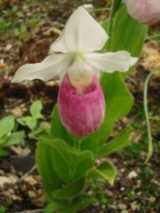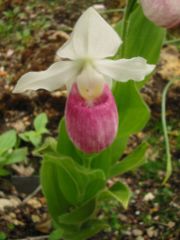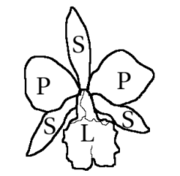
Labellum
Encyclopedia


Botany
In botany the labellum (or Lip) is part of an Orchid, CannaCanna (plant)
Canna is a genus of nineteen species of flowering plants. The closest living relations to cannas are the other plant families of the order Zingiberales, that is the gingers, bananas, marantas, heliconias, strelitzias, etc.Canna is the only genus in the family Cannaceae...
or other less known flower that serves to attract insects that pollinate the flower, and acts as a landing platform for those insects.
The labellum is a modified petal and can be distinguished from the other petals and from the sepals by its large size and its often irregular shape. It is not unusual for the other two petals of an orchid flower to look like the sepals, so that the labellum stands out as distinct.
Entomology
In entomology the term labellum has been used in referring to a prolongation of the labrumLabrum (arthropod mouthpart)
The labrum is a flap-like structure that lies immediately in front of the mouth in almost all extant euarthropods, the general exception being provided by the probable chelicerate-relatives the pycnogonids. It has proved to be by far the most controversial of all arthropod head structures. It is...
that covers the base of the rostrum in certain Coleoptera and Hemiptera
Hemiptera
Hemiptera is an order of insects most often known as the true bugs , comprising around 50,000–80,000 species of cicadas, aphids, planthoppers, leafhoppers, shield bugs, and others...
.
Currently the commonest use of the term is in the anatomy of the mouthparts of Diptera
Diptera
Diptera , or true flies, is the order of insects possessing only a single pair of wings on the mesothorax; the metathorax bears a pair of drumstick like structures called the halteres, the remnants of the hind wings. It is a large order, containing an estimated 240,000 species, although under half...
, particularly those in which the labium
Insect mouthparts
Insects exhibit a range of mouthparts, adapted to particular modes of feeding. The earliest insects had chewing mouthparts...
forms the bulk of the proboscis, such as in the housefly family
Muscidae
Muscidae are a family of flies found in the superfamily Muscoidea. The apical segment of the antennae of Muscidae are plumose, and the basal portion is smooth....
. Typically the labium is expanded distally
Anatomical terms of location
Standard anatomical terms of location are designations employed in science that deal with the anatomy of animals to avoid ambiguities that might otherwise arise. They are not language-specific, and thus require no translation...
into a pair of fleshy labella. In the early twentieth century it was argued that the labella are the modified labial palps, and that point of view still is seen as having merit. In flies such as the mosquitoes
Nematocera
Nematocera , is a suborder of elongated flies with thin, segmented antennae and mostly aquatic larvae, consisting of the mosquitoes, crane flies, gnats, and midges....
, that have long antenna
Antenna
Antenna may refer to:-Science and engineering:* Antenna , also known as an aerial, a transducer designed to transmit or receive electromagnetic Antenna (pl. antennas in radio/TV, antennae in biology) may refer to:-Science and engineering:* Antenna (radio), also known as an aerial, a transducer...
e, the labella are two separate organs, attached only to the proboscis at their bases, but in the flies with short antennae
Brachycera
Brachycera is a suborder of Diptera. It is a major suborder consisting of around 120 families. The most distinguishing characteristic of the suborder is reduced antenna segmentation...
, such as the house fly, they are more or less fused to form a single structure. Flies with fused labella have food channels in the surface of the labella. These are called pseudotracheae. They form the "spongy" part of a housefly's "tongue".

